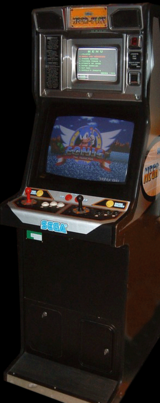Difference between revisions of "Mega Play"
From Sega Retro
(corrected and reworded some sentences; added missing games; merged galleries) |
|||
| Line 1: | Line 1: | ||
| − | [[Image:Megaplay2.png|thumb|right|160px|Sega | + | [[Image:Megaplay2.png|thumb|right|160px|Sega Mega Play arcade machine.]] |
| − | The ''' | + | The '''Mega Play''' is an arcade cabinet which used a JAMMA-based system to run [[Sega Mega Drive]] hardware and software. Unlike its predecessor the [[Mega-Tech]], coins increased credits rather than gameplay time, and no [[Master System]] games were available. All games were modified to remove cheats and extra lives. Mega-Tech games are not compatible with the Mega Play and vice versa. |
==Hardware== | ==Hardware== | ||
| − | The | + | The Mega Play internals consists of a uncased Genesis PCB, a four-slot multi-cart adapter, two built-in joysticks, and the appropriate coin-op and cart-switching hardware. Mega Play cartridges differ from standard Genesis cartridges in that they contained various encryption techniques and BIOS chips to prevent unscrupulous arcade owners simply swapping in the cheaper retail cartridges. The cartridges were also shaped like standard Japanese Mega Drive cartridges, to prevent them fitting into American and European home consoles. |
| − | + | Like the Mega-Tech the cabinet had two screens: a large gameplay screen in the center with a smaller instruction screen just above it. | |
| − | The | + | The multi-cart adaptor used in the Mega Play was later adapted and sold as an accessory for the home console, the "Video Jukebox" or "Mega Play 1010", which plugged into the console's cartridge slot. This version could take ten cartridges at once rather than the arcade version's maximum of four. |
| − | |||
| − | |||
| − | |||
| − | |||
| − | |||
==Games== | ==Games== | ||
| − | + | There are twelve games known to exist for the Mega Play hardware: | |
*''[[Bio-hazard Battle]]'' | *''[[Bio-hazard Battle]]'' | ||
*''[[Columns III]]'' | *''[[Columns III]]'' | ||
*''[[Golden Axe II]]'' | *''[[Golden Axe II]]'' | ||
*''[[Grand Slam]]'' | *''[[Grand Slam]]'' | ||
| + | *''[[Gunstar Heroes]]'' | ||
*''[[Mazin Wars / Mazin Saga]]'' | *''[[Mazin Wars / Mazin Saga]]'' | ||
*''[[Shinobi III]]'' | *''[[Shinobi III]]'' | ||
*''[[sonic:Sonic the Hedgehog (arcade game)|Sonic the Hedgehog]]'' | *''[[sonic:Sonic the Hedgehog (arcade game)|Sonic the Hedgehog]]'' | ||
*''[[sonic:Sonic the Hedgehog 2 (arcade game)|Sonic the Hedgehog 2]]'' | *''[[sonic:Sonic the Hedgehog 2 (arcade game)|Sonic the Hedgehog 2]]'' | ||
| + | *''[[Streets of Rage]]'' | ||
*''[[Streets of Rage II]]'' | *''[[Streets of Rage II]]'' | ||
*''[[Tecmo World Cup]]'' | *''[[Tecmo World Cup]]'' | ||
| − | == | + | ==Image gallery== |
<gallery> | <gallery> | ||
| − | Image:MegaPlayFlyer.jpg | + | Image:MegaPlayFlyer.jpg|Arcade flyer. |
| + | Image:megaplay.jpg|Sega Mega Play PCB. | ||
| + | Image:MM05p13.jpg|Home version for the Sega Genesis. | ||
</gallery> | </gallery> | ||
Revision as of 06:06, 28 June 2010
The Mega Play is an arcade cabinet which used a JAMMA-based system to run Sega Mega Drive hardware and software. Unlike its predecessor the Mega-Tech, coins increased credits rather than gameplay time, and no Master System games were available. All games were modified to remove cheats and extra lives. Mega-Tech games are not compatible with the Mega Play and vice versa.
Hardware
The Mega Play internals consists of a uncased Genesis PCB, a four-slot multi-cart adapter, two built-in joysticks, and the appropriate coin-op and cart-switching hardware. Mega Play cartridges differ from standard Genesis cartridges in that they contained various encryption techniques and BIOS chips to prevent unscrupulous arcade owners simply swapping in the cheaper retail cartridges. The cartridges were also shaped like standard Japanese Mega Drive cartridges, to prevent them fitting into American and European home consoles.
Like the Mega-Tech the cabinet had two screens: a large gameplay screen in the center with a smaller instruction screen just above it.
The multi-cart adaptor used in the Mega Play was later adapted and sold as an accessory for the home console, the "Video Jukebox" or "Mega Play 1010", which plugged into the console's cartridge slot. This version could take ten cartridges at once rather than the arcade version's maximum of four.
Games
There are twelve games known to exist for the Mega Play hardware:
- Bio-hazard Battle
- Columns III
- Golden Axe II
- Grand Slam
- Gunstar Heroes
- Mazin Wars / Mazin Saga
- Shinobi III
- Sonic the Hedgehog
- Sonic the Hedgehog 2
- Streets of Rage
- Streets of Rage II
- Tecmo World Cup
Image gallery
- MM05p13.jpg
Home version for the Sega Genesis.


